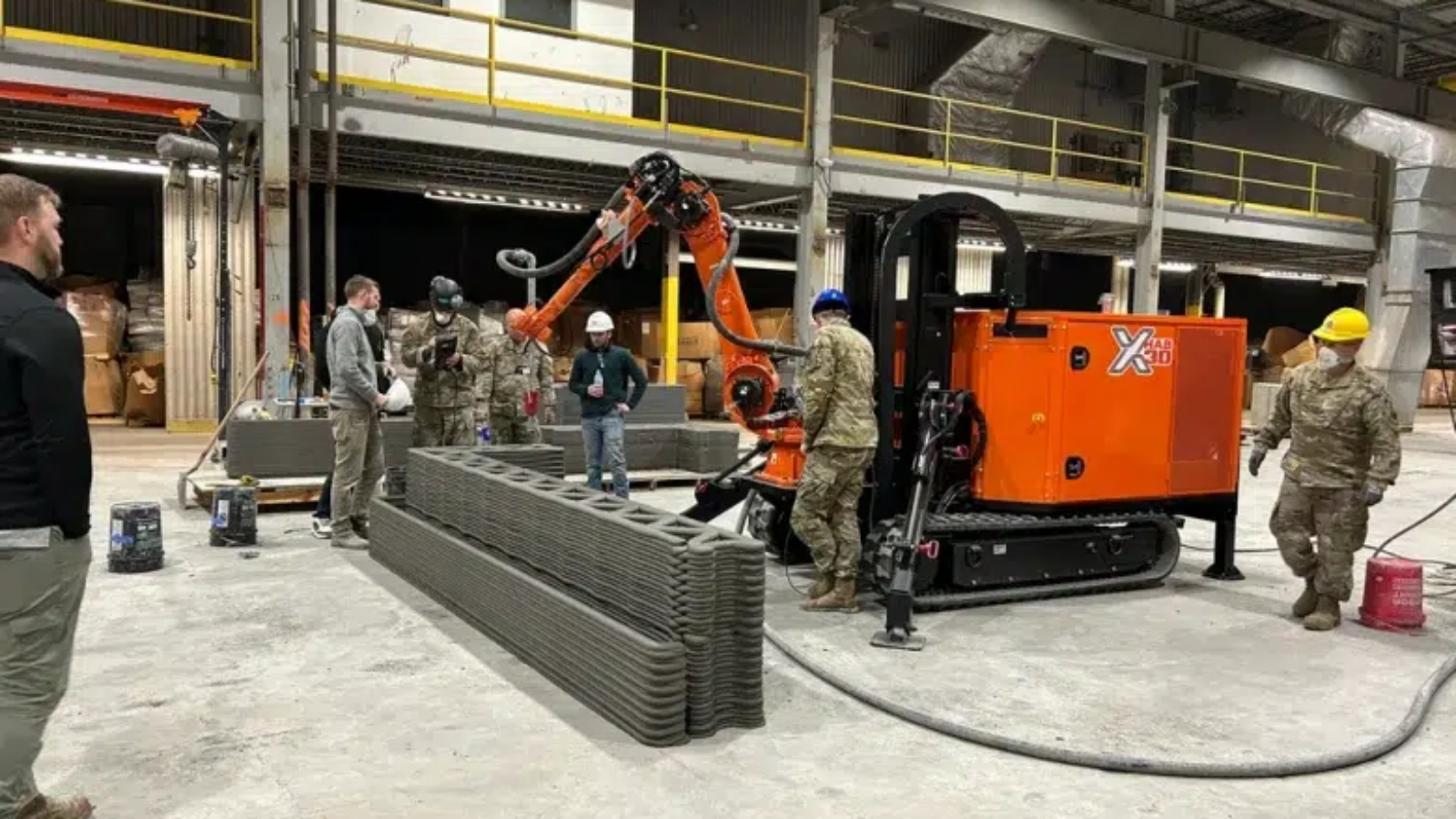According to DVIDS, the Expeditionary 3D Concrete Printer is being developed by the 175th Civil Engineer Squadron at Martin State Air National Guard Base, Maryland, to rapidly build fortified infrastructure that supports warfighters and sustains operations in contested environments.
“The idea came from carefully considering the role of Air Force Civil Engineers in future conflicts,” said Maj. Brian Vickers, Deputy Base Civil Engineer and project manager for the Expeditionary 3D Concrete Printer. “The Air Force Civil Engineer enterprise has been largely focused on base maintenance and sustainment for over a decade, and our ability to rapidly construct and repair austere airfields and infrastructure on a large scale will likely be strained in future conflicts.”
Traditional construction methods, while proven and reliable, can require significant manpower, time, and materials, as well as extensive skills – factors that can contribute to longer build times, increased costs, and added logistical complexity. In contrast, the Expeditionary 3D Concrete Printer streamlines construction with minimal manpower – just three Airmen – and uses one of the world’s most available materials.
“By building with concrete, occupants of these buildings are far more protected from blasts, fragmentation, and small-arms fire,” said Vickers. The ability to print curved walls, which offer superior blast resistance, coupled with concrete’s natural thermal properties, better enhances both survivability and energy efficiency. In an effort to improve blast resistance even further, the 175th CES team and partners from the Massachusetts National Guard and National Security Innovation Network (NSIN) are exploring the development of optimized, 3D concrete printed wall designs, which they then plan to subject to controlled-blast testing to validate.
The 175th CES team obtained Squadron Innovation Funds to initially test the printer’s feasibility. Through the AFWERX Refinery, the team also secured additional stakeholders and resources to expedite testing and potential adoption. Early trials proved successful but highlighted the need for ruggedization and portability. Alongside industry partner X-Hab 3D, the team modified the commercial model – reinforcing components, automating processes, and simplifying controls – to make it field-ready and combat-capable.
Manufacturing on Demand

Following training with the X-Hab 3D team at Penn State University in April 2024, the team transported the 3D printer to its new home at Martin State ANGB. This marked the 175th CES as the first operational Air Force unit with a 3D concrete printer. Wasting no time, they sprang into action and completed their first independent on-base print only the following month – proving not just the system’s viability, but that the project team is more than ready for the task.
Among notable milestones thus far has been a public demonstration at the National Mall, showcasing the technology’s potential to an audience of Congressional stakeholders. Another came when Tech. Sgt. Joshua Frost attempted to destroy the first print with a sledgehammer 18 hours after printing – and failed. “The concrete was so hard; far stronger than typical concrete, a tremendous nod to the potential uses of this technology,” said Vickers.
Looking ahead, collaboration with the US Army Corps of Engineers will seek to ensure additive manufacturing codes are updated to reflect advancements like the 3D concrete printer, aligning military standards to the future of building and design. The team is also looking to conduct soil-to-concrete research using native soils to understand how to possibly mitigate material sourcing challenges in different environments and in strategic military locations.
As for the next build project, the 175th CES plans to print a full-sized structure to house the piece of equipment. If successful, the structure has the potential to be “a model for a concrete replacement of the SSS Tent that has been a DoD standard for several decades,” said Vickers. “Our team was trained to use the 3D Concrete Printer in just four days – a remarkably fast timeline for such a revolutionary technology. If adopted, this capability could extend beyond RED HORSE (Rapid Engineer Deployable Heavy Operational Repair Squadron of Engineers) units to PRIME BEEF (Prime Base Engineer Emergency Force) units, significantly expanding the Air Force Civil Engineer enterprise’s construction and repair capabilities.”
Scaling the technology will require investment, training, and integration, but the benefits are undeniable. “Impactful innovations require impactful organizational change,” said Vickers.
Poised to revolutionize expeditionary construction, the Expeditionary 3D Concrete Printer offers the Air Force a faster, safer, and more resilient approach to infrastructure – reinforcing combat power through enhanced survivability and rapid response. The technology has the ability to enable Airmen to meet more highly complex mission demands and build what they need, when and where they need it.
You might also like:
Simpliforge Creations produces highest on-site 3D printed structure: The effort was led by Prof. K.V.L. Subramaniam of IIT-Hyderabad, Arun Krishnan, PhD scholar at IIT Hyderabad, and a multidisciplinary team. The structure, printed in just 14 hours using locally sourced materials, demonstrates how indigenous technology can deliver infrastructure rapidly and sustainably.
* This article is reprinted from 3D Printing Media Network. If you are involved in infringement, please contact us to delete it.
Author: Edward Wakefield


Leave A Comment